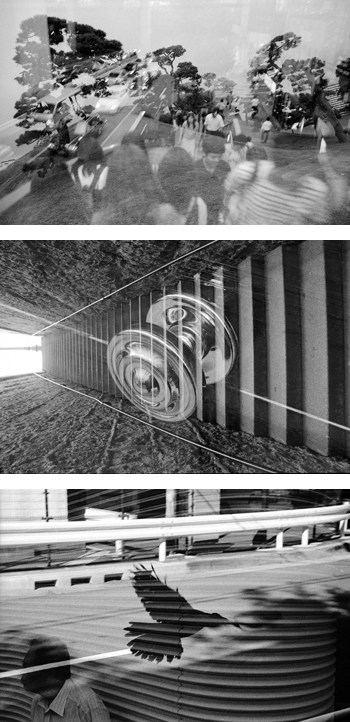
Jason Evans: NYLPT
by Aaron Schuman
Winter 2012
This essay was originally published in Aperture, Issue #209, Winter 2012.
Walking with Jason Evans—through city streets, across a university campus, or even around his own home—one realizes that he is a truly voracious looker. His eyes will frequently light up, a camera will appear in his hand, and the journey will veer in a new direction, even as the conversation maintains a steady flow. These forays provide an instantaneous insight into the interior reality, the internal experience of Evans in that moment. "Essentially, I'm just a street photographer—a traditional, very boring flâneur," he maintains, "[but] I'm capable of being a human being with a camera, not just a photographer."
What often distinguishes Evans's work from that of other practitioners is this multilayered and definitively "human" approach to photography. The emphasis is not only on what occurs in front of our eyes (and cameras); his work is also engaged in exploring the psychological power that is embedded in the act of seeing. Established in 2004, Evans's thedailynice.com is a webpage on which a single new photograph appears every day, and no archive is maintained. Partially intended as a therapeutic exercise for Evans himself, the site also provides both photographic and emotional stimuli for its audience—he regularly gets emails from fans who have found reassurance there. "I'd rather see something than look at it," Evans recently commented, "but you can only see by looking. When you really see something you get the feeling. . . .We see when we look, and then we feel."
Over the course of the past eight years, during trips to various cities known for their street- photography heritage—New York, London, Paris, Tokyo—Evans has compiled images for a new body of work, NYLPT, which again internalizes the photographic act, both technically and figuratively. (The project was published in book form last year by MACK, and as a progressively designed iPad app produced by MAPP.) Evans found it difficult to escape these cities' well-known photographic histories, which were embedded deep within his consciousness, so he began to shoot rolls of 35-millimeter black- and-white film in the traditional manner, then rewound and pocketed them. Later—days, weeks, months, even years later—he would pull out the same films in the same cities, and re-expose them, sometimes doing so up to five times without having a clue as to which images would overlap with one another. "I was missing that in photography: chance, happy accident, luck," he says. "The 'decisive moment' was no longer out there waiting to be hunted down. It had moved behind the lens, onto the film plane." The results are kaleidoscopic—as if a thousand-piece jigsaw puzzle had been tipped out of its box, and into each frame—and yet every photograph conveys a multilayered "feel" of its city, an amalgamation of Evans's own photographic experiences of each place with their combined effect on his psyche.
In a technical sense, by coopting the fundamental materials of street photography—35- millimeter black-and-white film—and then treating each frame as one might expose a digital sensor, Evans layers historical and current street-photographic strategies upon one another. As he wrote in his 2008 essay "Online Photographic Thinking": "In the inevitable and frankly tedious digital versus analog debate, my position is one of either/and. Both systems offer distinct possibilities, but I ultimately believe that they are just different sides of the same coin."
"The flâneur [ . . . ] is bombarded by a plethora of stimuli that cannot be completely assimilated," wrote Charles Baudelaire. "Accordingly, [he] must remain alert, vigilant and constantly on guard lest he experience psychological disintegration and loss of coherence." By surrendering his guard, by committing to the incoherence of contemporary experience, and by internalizing the "decisive moment" and then overlaying the resulting film plane with that of the mind, perhaps Evans proposes a new order—and new possibilities—for photographic observation; we feel when we see, and then we look.
Aaron
Schuman Photography
Copyright © Aaron Schuman, 2012. All
Rights Reserved.
This site and all of its contents may not be reproduced, in whole or in
part, in any form, without the written permission
of Aaron Schuman, and other additional artists involved in the production
of specific works exhibited on this site.